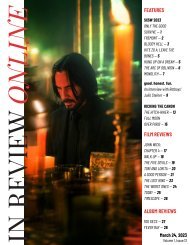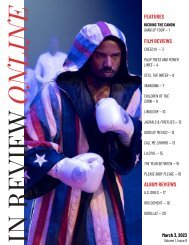InRO Weekly — Volume 1, Issue 10
Create successful ePaper yourself
Turn your PDF publications into a flip-book with our unique Google optimized e-Paper software.
KICKING THE CANON<br />
OF HUMAN FEELINGS<br />
Ornette Coleman<br />
There is perhaps no bolder album title in all of 20th century music than Ornette<br />
Coleman’s The Shape of Jazz to Come. And what’s more, it was entirely appropriate:<br />
Coleman’s arrival in New York City in 1959, followed shortly after by the record’s<br />
release, sent shockwaves throughout the jazz world. There were plenty of doubters<br />
who dismissed Coleman’s innovations as a fad, an affront to jazz tradition, but the<br />
test of time has proven that record’s wild proclamation to be true. There’s<br />
actually a shared theme among most of Coleman’s early album titles<br />
(Tomorrow Is the Question, Change of the Century) that, correctly,<br />
positions the jazz provocateur as a progressive force in the genre’s<br />
development <strong>—</strong> as well as a figure oriented toward the future. Crucially,<br />
though, Coleman’s music also has deep ties to the past. Consider a<br />
record like 1969’s Ornette at 12 <strong>—</strong> again, the title signals a focus on time,<br />
but going in the opposite direction. Ornette at 12 tapped into not only the<br />
music of Coleman’s youth (though that is a permanent consideration,<br />
too), but the uninhibited intuitiveness of being a child <strong>—</strong> a notion<br />
supported by the decision to have his then-12-year-old son, Denardo, on<br />
drums. Denardo would grow into a formidable player as an adult, but he was<br />
clearly an amateur in 1969 <strong>—</strong> and, indeed, his youthful abandon is more or less the<br />
point. Coleman may be commonly regarded as a forward-looking innovator, but to<br />
fully understand his work, one must also recognize its debt to the past <strong>—</strong> both in a<br />
historical and a personal sense. And there may be no better way to come to that<br />
understanding than to examine a less heralded period of Coleman’s career,<br />
which began around 1975 with the formation of his first electric band, Prime<br />
Time.Listening to Prime Time with 21st-century ears, the music still sounds a<br />
good deal more radical, more outlandish than Coleman’s ’60s quartet<br />
masterpieces. By the mid-’70s, the jazz fusion movement was in full swing, but Coleman’s<br />
electric jazz had little in common with Weather Report, Return to Forever, Mahavishnu<br />
Orchestra, or any of the other groups that sprung up in the wake of Miles Davis’ adoption of<br />
electric a half-decade earlier. Even today, there’s hardly any music that sounds like what<br />
Coleman was doing with Prime Time. The closest resemblance can probably be found in some<br />
of the more funk-inspired groups from the downtown New York no-wave scene, but none of<br />
those bands really approach the complexity and abstraction of Coleman’s outfit, nor do they<br />
embody its improvisational principles (and, of course, Prime Time anticipated no-wave by two<br />
or three years).<br />
Part of Prime Time’s uniqueness can be attributed to its unusual instrumentation. The typical<br />
lineup featured an arrangement that remains uncommon today: two electric guitarists, two<br />
electric bassists, two drummers, and Coleman on alto sax (with occasional trumpet and violin<br />
15
















